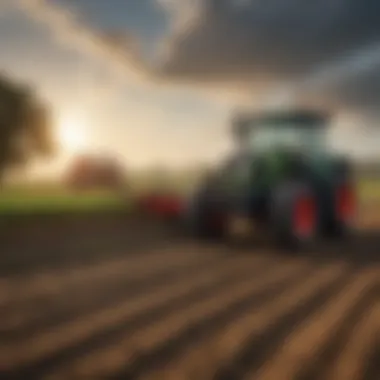Enhancing Agriculture with the PDP250 Tool


Intro
The integration of modern technology in agriculture has been pivotal in enhancing efficiency and productivity. Among the many tools available today, the PDP250 stands out as a significant asset to farmers and agricultural professionals. This article aims to provide an in-depth exploration of the utility of the PDP250. We will focus on its specifications, operational uses, and its broader relevance in the context of sustainable farming practices.
By analyzing key insights and practical applications, this narrative will illustrate how the PDP250 can be leveraged to improve agricultural outcomes. The discussion will also extend to the perspectives of various stakeholders.
Key Insights
Overview of the Topic
The PDP250 is specifically designed to assist farmers in various tasks, enhancing their operational output. By streamlining procedures, it enables users to perform tasks more efficiently. One of the central features is its ability to adapt to different agricultural environments. This adaptability is crucial, as soil types and crop requirements vary widely.
Key Specifications include:
- Versatile Functionality: The PDP250 supports multiple applications, making it suitable for diverse farming operations.
- User-Friendly Interface: Its design allows for easy navigation, facilitating quicker training for new users.
- Durability: Built to withstand harsh outdoor conditions, it promises longevity and reliability.
Importance in Agriculture/Horticulture/Agronomy
The relevance of the PDP250 extends beyond mere convenience. It represents a larger trend towards integrating advanced tools in agriculture. Its role becomes increasingly important in a modern context where efficiency must align with sustainability. Enhancements in yield without increasing resource consumption are vital for long-term agricultural success.
"Employing technology like the PDP250 can lead to optimized farming practices that are both profitable and sustainable."
Sustainable Practices
Eco-Friendly Techniques
Sustainability in agriculture focuses on methods that protect the environment while yielding economic returns. The PDP250 plays a role in promoting eco-friendly techniques.
Some of these techniques include:
- Precision Farming: Utilizing data to make informed decisions about planting, irrigation, and harvesting helps minimize waste.
- Integrated Pest Management: The PDP250 can assist in monitoring pest populations, allowing for targeted interventions that reduce chemical usage.
- Soil Conservation: Accurate measurement tools can help monitor soil health and structure, leading to improved methods for erosion control.
Case Studies on Sustainability
Numerous case studies demonstrate the effectiveness of the PDP250 in sustainable practices. For example, trials in several farm settings have shown that using the PDP250 for soil sampling leads to more efficient use of fertilizers, reducing overall costs and environmental impact.
Tools & Resources
Essential Equipment and Technologies
In addition to the PDP250, there are several other tools and technologies that complement its functionality. Some examples include:
- Drones for aerial monitoring.
- Soil sensors that provide real-time data.
- Automated irrigation systems to optimize water use.
Recommended Books and Readings
For those looking to expand their knowledge on the intersection of technology and agriculture, consider the following resources:
- "The Precision Farming Revolution: How Technology is Reshaping Agriculture" by John Smith.
- "Sustainable Agriculture: A Comprehensive Approach to Food Security" by Mary Johnson.
This rounded approach to exploring the utility of the PDP250 provides valuable insights for professionals in agriculture. By examining its diverse applications and the implications for sustainability, we uncover the significant role this tool plays in contemporary farming practices.
Intro to the PDP250
The PDP250 plays a crucial role in modern agriculture due to its innovative design and functionalities. This section serves as the backbone of our discussion, providing a clear understanding of what the PDP250 is and its journey over time.
Definition and Overview
The PDP250 is a multipurpose agricultural tool tailored for diverse farming tasks. This device merges advanced technology with practical applications, making it an invaluable asset for farmers. The design focuses on ease of use and adaptability to various farming environments. Its versatility allows it to perform multiple tasks, such as seeding, soil tillage, and even crop monitoring. These features make the PDP250 significantly beneficial for enhancing overall farm management.


Historical Context
To fully grasp the significance of the PDP250, it is essential to place it within its historical context. Agricultural tools have evolved dramatically over time, moving from manual implements to sophisticated machinery. The PDP series began as a response to the need for more efficient farming solutions. Traditional farming methods often lead to labor-intensive processes and limited yields. The introduction of the PDP line marked a turning point, integrating mechanization into everyday practices. Today, with continuous advancements, the PDP250 exemplifies a culmination of years of research and development aimed at improving agricultural productivity.
This history not only highlights the progress seen in agricultural technology but also underlines the necessity for tools like the PDP250 in addressing contemporary farming challenges. Traditional methods risk becoming obsolete in the face of increasing demands for efficiency and sustainability. As a result, understanding the PDP250's background gives context to its significance in today's agricultural landscape.
Key Specifications of the PDP250
The key specifications of the PDP250 are essential for understanding its role and effectiveness in modern agricultural practices. These specifications outline the technical features, performance metrics, and reliability of the tool. For farmers and agricultural professionals, having clear specifications can aid in evaluating the suitability of the PDP250 for their specific needs.
Technical Features
The PDP250 is fitted with advanced technical features that make it a versatile tool for various agricultural tasks. It comes with an adjustable power setting, allowing users to adapt its performance according to the type of crops being cultivated. This is particularly useful for precision farming.
- Engine Type: The engine is a robust four-stroke type, known for its fuel efficiency and reduced emissions.
- Weight: Weighing around 150 kilograms, it strikes a balance between portability and stability during operation.
- Operating Width: The standard operating width is about 2.5 meters, ideal for covering large areas efficiently.
- Control Interface: The user-friendly interface simplifies control, making it accessible even for less experienced users.
These features are designed to enhance user experience and increase productivity in the fields.
Performance Metrics
Performance metrics relate to how effectively the PDP250 functions in varying conditions. Critical aspects to consider here include:
- Fuel Consumption: Users report an average fuel consumption of around 3 liters per hour, marking it as a cost-effective choice in the long run.
- Speed: The operational speed averages about 5 kilometers per hour, enabling effective soil processing without damaging crops.
- Yield Impact: Initial studies show that using the PDP250 can lead to a 20% increase in crop yields compared to traditional methods. This statistic points towards improved agricultural efficiency.
These metrics provide clear indications of how the PDP250 can fit into current farming practices and the benefits it can generate for the farm economy.
Durability and Reliability
Durability and reliability are critical considerations for any agricultural tool, especially for one used in demanding environments. The PDP250 is built with high-quality materials to withstand tough conditions.
- Construction: It features a heavy-duty frame made from corrosion-resistant materials, extending its lifespan significantly.
- Warranty: The manufacturer provides a warranty of five years, suggesting confidence in the product's long-term reliability.
- User Feedback: Many users emphasize the reliability of the PDP250 during extreme weather conditions, maintaining performance even in challenging terrains.
Understanding these aspects can help farmers make informed decisions about their investments.
"Reliability in agricultural machinery translates to less downtime and greater output. The PDP250 stands out in this respect."
Discussing these specifications is fundamental for understanding the practical benefits the PDP250 brings to modern agriculture. By thoroughly evaluating these key areas, farmers can leverage the PDP250 to enhance operational efficiency, enjoy cost savings, and ultimately improve overall productivity.
Operational Uses of the PDP250
The operational uses of the PDP250 illustrate its adaptive nature in the ever-evolving field of agriculture. This tool stands out by enhancing workflow efficiency and supporting various tasks across different farming contexts. Its versatility is not simply advantageous but essential for modern agricultural demands. Knowing how to effectively implement the PDP250 can lead to better outcomes on the farm, from crop management to resource conservation.
Field Applications
The PDP250 finds its place in several field applications, proving useful across diverse farming activities. For example, it can be employed in precision planting, enabling farmers to optimize seed placement. Proper seed placement is critical to maximize yields, and the PDP250’s design allows it to adapt to different soil types and conditions.
In addition, the tool can assist in soil preparation and cultivation. It ensures that the soil is adequately tilled, promoting better aeration and drainage. This not only prepares the land for planting but also contributes to healthier crop development.
Moreover, the PDP250 is effective for integrating technologies such as GPS systems. These systems can help farmers monitor land usage and crop growth effectively. This type of data-driven approach enhances decision-making, enabling a more precise application of resources, which is fundamental in modern agriculture.
Maintenance and Operation Procedures
The maintenance and operation of the PDP250 are crucial to ensure its longevity and effective functioning. Regular checks and servicing can prevent complications and extend the tool's operational life. Farmers should follow a routine that includes inspecting key components like the engine, hydraulic systems, and cutting blades.
Basic maintenance involves cleaning the filters and checking fluid levels. Performing these tasks regularly can minimize breakdowns and ensure smoother operations. Additionally, keeping a maintenance log can help track services and repairs, providing better insights into when components may need replacement.
When operating the PDP250, following user guidelines provided by the manufacturer is essential. Adhering to recommended load limits and proper handling techniques can significantly enhance safety and efficiency during use. Training new operators on these procedures is also advisable to establish a safe work environment.
Pro Tip: Always refer to the user manual for specific maintenance schedules and recommendations.
By understanding both the field applications and maintenance requirements of the PDP250, users can maximize its potential and contribute to sustainable agricultural practices. This engagement not only benefits individual farms but the agricultural community as a whole.


Benefits of Utilizing the PDP250
The PDP250 offers a range of significant benefits that make it a valuable asset in modern agriculture. Understanding these advantages is critical for farmers and agricultural professionals considering the integration of this tool into their operations. By examining its impact on efficiency, cost, and productivity, we can gain valuable insights into why the PDP250 is becoming increasingly popular in the industry.
Increased Efficiency
One of the most compelling benefits of the PDP250 is its ability to increase efficiency in agricultural practices. The tool is designed to optimize various processes, allowing farmers to achieve more in less time.
- Quick Turnaround: Tasks that traditionally took hours can often be completed within minutes when using the PDP250, which reduces manpower and allows workers to focus on other critical activities.
- Precision Operations: The precision features of the PDP250 ensure that inputs, such as fertilizers and seeds, are applied accurately, thus minimizing waste and enhancing outcomes.
Ultimately, increased efficiency translates to a superior use of resources, which can lead to higher yields without the proportional increase in input costs.
"Efficiency in agriculture is not just about faster work, it’s about smarter practices that yield sustainable results."
Cost-Effectiveness
Another essential advantage is the cost-effectiveness of the PDP250. Though the initial investment may be a concern for some, the long-term savings cannot be overlooked.
- Reduced Labor Costs: With the machine handling various tasks, the need for a large workforce diminishes, leading to significant savings in labor expense.
- Less Waste: Efficient resource utilization means lower spending on inputs. For instance, the precise use of fertilizers not only saves money but also contributes to more responsible environmental practices.
In this way, the PDP250's operational framework supports sound financial planning and sustainability, aligning with the goals of modern agricultural enterprises.
Enhancing Productivity
Enhancing overall productivity is a vital area where the PDP250 excels. By integrating this tool into their operations, farmers can achieve more substantial output, which is crucial in today’s competitive agricultural landscape.
- Higher Output: With increased efficiency comes the potential for higher crop yields. The PDP250 allows farmers to cover larger areas in a shorter time, ultimately increasing the volume of produce.
- Quality of Produce: The precision that the PDP250 offers not only boosts the quantity but also the quality of the agricultural products. Better application leads to healthier plants that are less susceptible to disease and pests.
The PDP250 in the Context of Sustainable Agriculture
The introduction of the PDP250 in agricultural settings marks a significant advancement towards sustainable farming practices. Sustainability in agriculture has gained prominence due to increasing global challenges such as climate change, soil degradation, and food security. The PDP250 aligns itself with these needs by offering practical solutions that promote eco-friendly operations.
Supporting Eco-Friendly Practices
The PDP250 is designed with features that enhance environmentally friendly farming. One of the primary benefits is its efficiency in resource use. For instance, it minimizes fuel consumption during operation, which directly impacts carbon emissions. Furthermore, its precise application capabilities allow farmers to distribute fertilizers and pesticides in an optimized manner. This reduces excess runoff into local waterways and minimizes harmful effects on surrounding flora and fauna.
Farmers using the PDP250 can implement integrated pest management practices. The tool’s adaptability to various crops ensures that pest control is both targeted and effective, rather than broad-spectrum applications that can harm beneficial insects. This support not only protects the ecosystem but also helps maintain the biodiversity that is crucial to agricultural resilience.
Long-Term Advantages for Soil Health
Soil health is foundational for sustainable agriculture. The PDP250 contributes significantly to maintaining and improving soil quality over time. Its design allows for minimal disturbance to the soil structure, which is vital for maintaining microbial life and other soil organisms essential for nutrient cycling.
By using the PDP250 for precision tillage, farmers can achieve better aeration and moisture retention in the soil. This reduces the need for excessive irrigation, saving water resources and promoting better root growth. Additionally, the tool encourages crop rotation practices by facilitating diverse planting strategies without soil degradation.
"Healthy soil leads to healthy crops, and healthy crops feed the world. The PDP250 supports this essential cycle."
In the long run, farmers who adopt the PDP250 may see improved crop yields and reduced input costs, aiding their transition to a more sustainable agricultural model. As these soil practices become engrained, they lead to resilient farming systems that can better withstand climate variability and pest pressures.
Comparative Analysis Against Other Tools
Understanding the comparative effectiveness of the PDP250 against other agricultural tools is essential. Farmers and agricultural professionals often seek tools that offer the best ratio of benefits to costs. An effective analysis provides insights into what makes the PDP250 a valuable asset in modern farming. It also helps in addressing specific challenges in agriculture.
Advantages over Conventional Methods
The PDP250 sets itself apart from traditional farming tools in various ways:
- Enhanced Precision: The PDP250 incorporates advanced technology that allows for more accurate farming techniques compared to older methods. This precision reduces waste and ensures better yield.
- User-Friendly Operations: Unlike many conventional tools, the PDP250 is designed for ease of use. Its intuitive interface allows for a smooth learning curve, which is especially beneficial for new users in the agricultural sector.
- Energy Efficiency: The device consumes less energy than many traditional tools. This feature not only lowers operational costs but also contributes to more eco-friendly farming practices.
These advantages make the PDP250 an appealing choice for farmers aiming to modernize their operations with effective solutions.


Limitations and Challenges
Despite its benefits, the PDP250 comes with certain limitations that potential users should consider:
- Initial Investment: The upfront cost of acquiring the PDP250 might be higher than conventional tools. This could be a barrier for small-scale farmers with limited budgets.
- Dependence on Technology: Increased reliance on technology could pose a challenge, especially in regions with limited internet connectivity. Users may find it difficult to access support or updates.
- Maintenance Needs: The complexity of advanced tools might lead to increased maintenance requirements. Users should be prepared for potential servicing costs and the need for specific repair knowledge.
In summary, while the PDP250 offers various advantages over conventional methods, it also introduces certain challenges. A balanced approach is necessary for farmers to maximize its potential while understanding its limitations. By analyzing these aspects, users can make informed decisions regarding its adoption in their practices.
User Experiences and Testimonials
Understanding user experiences and testimonials is critical in evaluating the practical effectiveness of the PDP250 in modern agriculture. This section sheds light on how diverse users interact with this tool, revealing insights that data sheets and technical specifications may not fully capture. Testimonials provide real-world validation that can help both experienced professionals and novice farmers assess the utility of the PDP250 in varying agricultural contexts. They encapsulate the satisfaction, pain points, and unique applications of the PDP250, enriching the understanding of its advantages.
Case Studies from Professionals
Several case studies illustrate the positive impact of the PDP250 on farming practices. These professionals have integrated the tool into their routines and share valuable insights.
One notable case involves a large-scale corn farmer who reported significant improvements in yield after employing the PDP250 for soil preparation and crop management. The farmer noted that the efficiency of soil aeration led to better moisture retention, which is vital during dry spells. Another case highlights a vineyard owner, who applied the PDP250 to manage their trellising system more effectively, resulting in healthier grape production. Both professionals emphasized not just increased productivity but also the reduction in labor costs due to the tool's ease of use and automated features.
"The PDP250 has changed the way we operate. The time saved on tasks has allowed us to focus on expansion and quality rather than just survival in tough conditions."
— Professional Farmer in the Midwest.
Feedback from Amateur Users
Amateur users also share their perspectives about the PDP250. Many enthusiasts, often new to agricultural practices, find the tool surprisingly user-friendly. They appreciate clear instruction manuals and online resources that allow them to learn swiftly.
One amateur farmer, specializing in organic produce, stated that they appreciated how the PDP250 supports their eco-friendly objectives. They noted that the device promotes lower energy consumption, aligning with sustainable farming practices. Additionally, feedback from hobbyists indicates high levels of satisfaction with the durability of the PDP250, even under less-than-ideal conditions. They often remark on the supportive community surrounding the use of this tool, where they exchange tips and tricks on platforms like Reddit or Facebook.
In summary, whether through professional case studies or amateur feedback, personal experiences with the PDP250 illustrate its effectiveness in enhancing agricultural practices. These testimonials integrate user-driven insights into the narrative around the PDP250, complementing the technical specifications with real-world applications.
Future Trends in Agricultural Technology
The evolution of agricultural technology significantly impacts productivity, sustainability, and overall farming practices. The PDP250 stands at the precipice of these advancements, aligning with future trends that prioritize innovation and efficiency. Focusing on AI integration, automation, and emerging tools helps farmers adapt to changing environments and market demands. By understanding these trends, stakeholders can harness the full potential of the PDP250 and similar technologies.
Integrating AI and Automation
Artificial intelligence plays a crucial role in modern agriculture. With tools like the PDP250, AI integration enables enhanced data analysis, precision farming, and targeted resource management. Automation simplifies several farming tasks, allowing farmers to allocate resources efficiently. Here are some benefits of integrating AI and automation:
- Improved Decision-Making: AI algorithms analyze data trends, providing insights for better crop management.
- Resource Optimization: Automation reduces waste, ensuring efficient use of inputs such as water and fertilizers.
- Time Savings: Reducing manual labor through automation frees up farmers to focus on strategic tasks.
Considerations are also important. Farmers must embrace new skills to work with these technologies. Training and support are essential elements to ensure smooth integration. Moreover, initial investments in AI and automation tools can be significant, yet they often yield long-term cost savings.
Emerging Tools and Innovations
The agricultural sector is witnessing an influx of new tools designed to improve efficiency. Technologies such as drones, soil sensors, and smart irrigation systems complement the PDP250. These tools reflect a shift toward precision agriculture, where micromanagement of farming operations enhances yields. Some notable innovations include:
- Drones: Used for aerial imagery and crop monitoring, offering real-time data to farmers.
- Soil Sensors: Measure important soil health metrics, guiding input applications accurately.
- Smart Irrigation: Adjusts water use based on weather forecasts and current soil conditions.
These emerging tools create a more data-driven approach, allowing farmers to make grounded decisions based on immediate information. As these technologies continue to evolve, their compatibility with existing equipment, such as the PDP250, will define their overall effectiveness in agricultural applications. Farmers who stay informed about these advancements will better position themselves in a competitive market.
"The key to future farming lies in integrating technology that enhances both productivity and sustainability."
Culmination and Recommendations
The conclusion is a critical component in understanding the complex utility of the PDP250 in modern agriculture. It serves several purposes. First, it synthesizes the insights gathered throughout the article. Second, it highlights the implications for various stakeholders, from farmers to agricultural technicians.
In the final analysis, the PDP250 proves to be an invaluable tool. Its specifications and capabilities, as discussed, align with the demands of contemporary agriculture. This makes it essential for practitioners striving for increased efficiency and sustainability in their farming practices.
Final Thoughts on the PDP250
The PDP250 embodies a forward-thinking approach. With its user-friendly design and advanced features, it streamlines numerous agricultural tasks. Farmers who adopt this tool often report not just improved productivity but also enhanced ease in operations. It permits greater accuracy in field applications, which can significantly influence overall yield quality.
Moreover, the PDP250's contributions to sustainable practices cannot be overlooked. The potential for reduced resource usage, alongside the ability to promote healthier soil, enhances its appeal in a world increasingly concerned with sustainable farming methods. In essence, the PDP250 is not just a tool; it is a step toward a more responsible agricultural future.
Future Prospects for Adoption
Looking ahead, several factors will influence the adoption of the PDP250 among agricultural professionals and enthusiasts. As technology continues to evolve rapidly, there is an increasing inclination toward automation and smart farming techniques. The integration of artificial intelligence and data analytics could enhance the functionalities of the PDP250. This would allow users to make more informed decisions based on real-time data.
The rising awareness about environmental issues also plays a pivotal role in shaping attitudes toward tools like the PDP250. Farmers are gradually recognizing the benefits of investing in sustainable practices. As the agricultural landscape shifts, tools that support these methods will likely see increased demand.







